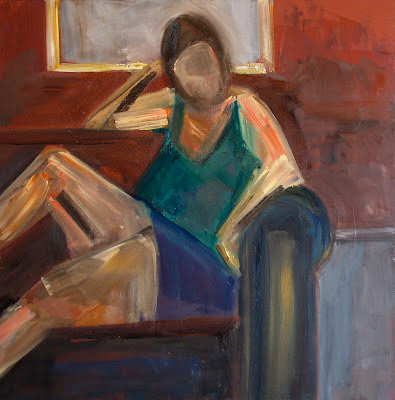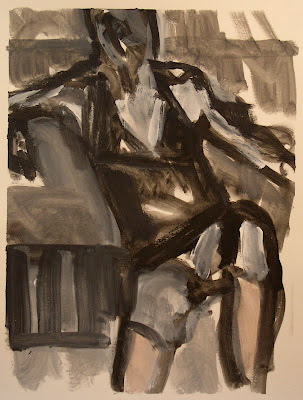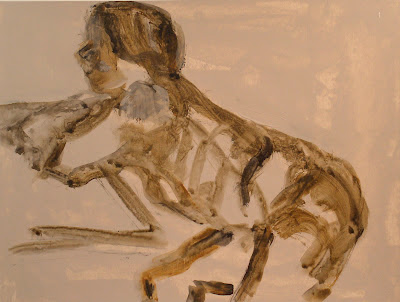(Written entry follows images).
 |
| Red Couch-Version 8 |
 |
| Red Couch-Version 15 |
 |
| "The Red Couch" (Artists & Model series), oil on canvas, 60" x 48" |
***********************************************************************************
 |
| Dark Stockings-Version 4 |
 |
| Dark Stockings-Version 10 |
 |
| "Dark Stockings" (Artist & Model series), oil on canvas 36" x 36" |
PROBLEMATIC, ABSTRACT & PERSONAL
The new paintings are working in a way I’ve long intended,
but the process of painting has become harder for me to fathom. Some of the
pieces are large and studio sessions for them are long, but the change in
process can’t be entirely attributed to scale or time. Here I take process to
mean something in addition to method, something that is more—for lack of a
better word—internalized.
The method itself has remained much the same for the last
few years: drawing--but not often painting--from the model; drawing at the
beach, in cafes and on the street; assembling photos and drawings as sources
for studio work. What has become insistently clear in the last few months is
the crucial role played by elements in the title; the problematic, the abstract and the
personal. These days they seem almost as essential as paint and turp. And they’re elemental in my heart, not
just in my head.
I used to think the stubborn difficulties in painting were
purely signs of faulty construction or weak skills. And it’s clear to anyone
who cares to look, that plenty of those basics are still missing from my work.
Like most people, I rarely feel the need to seek out hardships. Smooth sailing
and grace notes are welcome here--but the problematic moments in painting are
something of equal value. As they stand in your way, they also turn you. They
can shout all day long, “Not this way! Not this way either!” They can exhaust
you—sometimes I think the prime purpose of these perceived barriers IS to
exhaust you—to the point where it’s almost--almost--impossible to hear, “Yes , this way.”
To be truthful, sometimes you never hear it.
I realize now that the abstract qualities of a piece, far
from being something I invented, are the tools I need to complete the
work. The most meticulously “realistic” portraits rendered in square blobs
(Chuck Close) or thick lines (Alice Neel) are evidence of the long-running
relationship between the abstract and the practical. I’ve come to see that, for
me, there is nothing more useful than abstract color or form to construct an
ear or enlarge a cloud or to
translate an ambiguous light.
The personal element is the most mysterious one. It acts as
a kind of clairvoyant shopping list. What I want to know and what I never want
to know are present there in equal measure. This can’t be psychologized or
art-historisized away, it can only be experienced, like these lines from
George Oppen:
“In dream an old man walking,
An old man’s rounded head
Abruptly mine”


















































